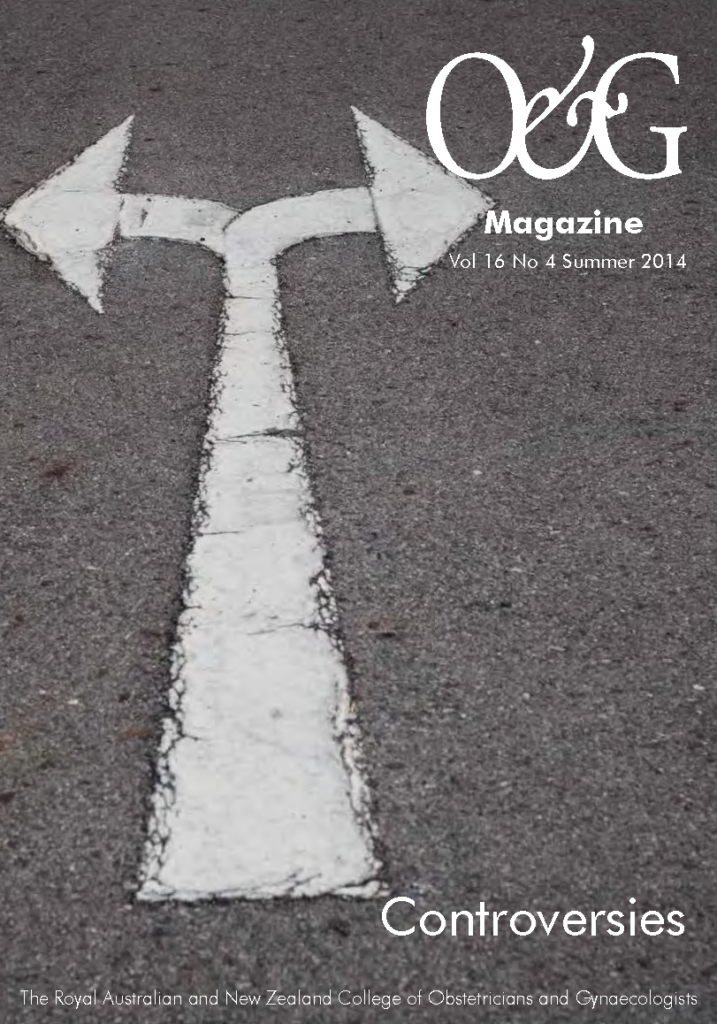Had time to read the latest journals? Catch up on some recent O and G research by reading these mini-reviews by Dr Brett Daniels.
Paracetamol in pregnancy
Paracetamol is one of the drugs most commonly used by pregnant women and is listed as category A by the Australian Drug Evaluation Committee. Paracetamol has been used for many years during pregnancy and is generally thought to be very safe.
Thompson et al report on 871 children in the Auckland Birthweight Collaborative Study.1 Initially enrolled at birth between 1995 and 1997, the study reports the results of child behaviour by parent report at age seven and by parent and child reports at age 11. Reports were standardised using the Strengths and Difficulties Questionnaire (SDQ). Use of analgesics, including paracetamol, was ascertained by interviews conducted soon after the study enrolment, following birth of the child. Paracetamol was by far the most common analgesic used by the mothers during pregnancy, with 49 per cent of women reporting use compared with 5.3 per cent using aspirin and 1.3 per cent using other anti-inflammatories.
The results show that there were significantly higher scores on the SDQ in children of mothers who had taken paracetamol during pregnancy, compared to those who had not, at both seven and 11 years of age. The authors conclude that paracetamol use during pregnancy is associated with a higher risk of attention deficit hyperactivity disorder later in childhood. There was not a similar association with the other analgesics or antibiotics included in the study. If this result is replicated in larger long-term studies it will of interest to many pregnant women.
- Thompson JMD, Waldie KE, Wall CR, et al. (2014) Associations between acetaminophen use during pregnancy and ADHD symptoms measured at ages 7 and 11 years. PLOS ONE, 9: e108210.
Term breech delivery
Since the Term Breech Trial there has been an increase in the overall caesarean rate for breech presentations. Sullivan et al report that, in 2005, the elective caesarean rate for breech presentation in Australia was 77 per cent, with an overall caesarean rate of 96 per cent.1 One consequence of this is that current data regarding the safety of vaginal breech birth has become scant. In the Netherlands, however, the elective breech caesarean rate is 60 per cent with a total caesarean rate for breech delivery of 80 per cent. This paper analyses neonatal outcomes for breech deliveries following the publication of the Term Breech Trial, in 2000, with particular emphasis on the outcomes of the 40 per cent of women selected for planned vaginal delivery.2 The authors analysed 1.4 million term deliveries from the Netherlands Perinatal Registry 1999–2007, of which more than 58 000 were breech. The selection of these years allowed them to analyse changes in breech delivery before and after the Term Breech Trial: the elective caesarean rate increased from 24 per cent before to 60 per cent afterwards. There was an accompanying reduction in the overall perinatal mortality rate from 1.3 per cent to 0.7 per cent (OR 0.51; 95 per cent CI 0.28–0.93), with a larger effect in nulliparous compared with multiparous women. There were also reductions in low Apgar score and neonatal trauma. In women having a planned vaginal delivery, there was no decrease in perinatal mortality after November 2000 (1.7 per cent versus 1.6 per cent; OR 0.96; 95 per cent CI 0.52–1.76). The authors calculated a number needed to treat of 338 elective caesareans to prevent one perinatal death. Interestingly, the authors report a range of planned breech caesarean rates in different institutions from 14–80 per cent. They attempted to identify subgroups of women in which planned vaginal delivery would be safe, but were unable to do so from the data, suggesting elective caesarean section would be the safer option for most women with a breech presentation at term.
- Sullivan EA, Moran K, Chapman M. 2009. Term breech singletons and c-section: a population study. ANZJOG, 49: 456-460..
- Vlemmix F, Bergenhenegouwen L, Schaaf JM, et al. 2014. Term breech deliveries in the Netherlands: did the increased cesarean rate affect neonatal outcome? A population-based cohort study. ACTA Obstetrica et Gynecologica Scandinavica, 94: 888-896.
Long-acting contraception and teenage pregnancy
The teenage pregnancy rate in Australia is about 15 births per 1000 girls aged 15–19 while it is about 26 per 1000 in New Zealand.1 Teenage pregnancy is associated with social and financial costs including decreased educational attainment and welfare dependence. Long-acting reversible contraceptives (LARCs) including implants and intrauterine devices (IUDs) have been associated with decreased rates of teenage pregnancy, but fewer than five per cent of US teens report using them despite them being acceptable to them. A new study reports on an innovative program in which women are provided standardised information regarding reversible contraceptives, with an emphasis on LARCs, and provided with the contraceptive of their choice at no cost.2 The Contraceptive CHOICE program targeted unplanned pregnancy in girls and women aged from 14 to 45 years of age, although this paper reports on data from 1404 teenage girls. After the education and counselling part of the project, 35 per cent of girls chose an etonogestrel implant, 32 per cent chose a hormonal IUD, five per cent chose a non-hormonal IUD while 13 per cent chose the oral contraceptive pill and five per cent chose a contraceptive ring. Prior to enrolment in the project, 97 per cent of participants were sexually experienced, 47 per cent had had an unintended pregnancy, 18 per cent had had an abortion and 24 per cent had had a diagnosis of a sexually transmitted disease. At one, two and three years 92 per cent, 82 per cent and 75 per cent of participants were available for follow up. During the follow-up period, participants in the CHOICE project had much lower rates of pregnancy, births and abortion compared to sexually experienced teenagers (34/1000 versus 159/1000, 19/1000 versus 94/1000 and 10/1000 versus 42/1000, respectively). This article shows that the rates of teenage pregnancy may be substantially reduced by provision of no-cost long-acting contraception.
- UNICEF Office of Research (2013). Child Well-being in Rich Countries: A comparative overview, Innocenti Report Card 11, UNICEF Office of Research, Florence.
- Secura GM, Madden T, McNicholas C, et al. 2014. Provision of no cost, long-acting contraception and teenage pregnancy. N Engl J Med, 371: 1316-1323.






Leave a Reply